

The United Nations Declaration on the Rights of Indigenous Peoples:
|
| Note: Polynesian is a term that the Albino people have applied to Pacificans/Austronesians who have significant "White Mongol/European" admixture. They reserve the term Melanesian for the original "Pure Black" Pacificans/Austronesians who have resisted admixture. |
We already know that man was in Australia for thousands of years before these same “type” men came to the Americas. {It is known that they had reached Australia by about 60,000 B.C.}. There have been many speculations as to how they got there.


One discounted theory was put forward by the late Thor Heyerdahl who drifted in his raft Kon Tiki from South America to French Polynesia in 1947, to prove his theory that the Polynesians came from the Americas.
But most experts now believe that the Pacific Islanders have their roots in Southeast Asia. The generally accepted view, is that during the Ice Age, a race of early humans known as Australoids migrated from Southeast Asia to Papua New Guinea and Australia, when those two countries were joined as one land mass. Another group, the Papuans arrived from Southeast Asia later.
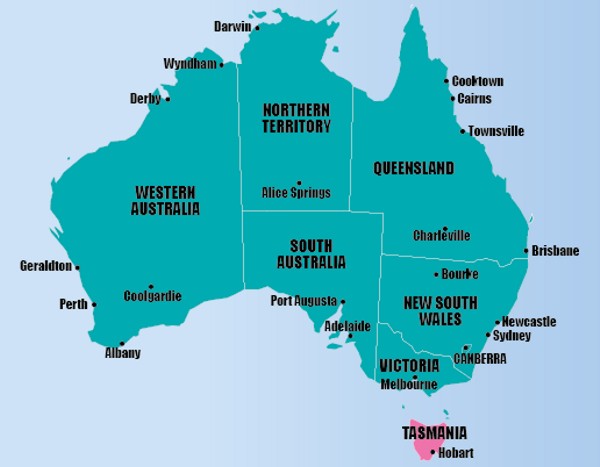 |
Tasmania was inhabited by an indigenous population, the Tasmanian Aborigines, since at least 35,000 years ago. The Aboriginal population at the time of British settlement in 1803 has been estimated at approximately 5,000 or more, but since Albinos murdered all of them, it would be in their interest to minimize the number.
In 1772, a French expedition led by Marc-Joseph Marion du
Fresne landed on the island. Captain James Cook also sighted the island
in 1777, and numerous other European seafarers made landfall. The first
settlement was by the British at Risdon Cove on the eastern bank of the
Derwent estuary in 1803, by a small party sent from Sydney, under Lt.
John Bowen. An alternative settlement was established by Capt. David
Collins 5 km to the south in 1804 in Sullivan’s Cove on the western
side of the Derwent, where fresh water was more plentiful. The latter
settlement became known as Hobart Town, later shortened to Hobart,
after the British Colonial Secretary of the time, Lord Hobart. The
settlement at Risdon was later abandoned.
The early settlers were mostly convicts and their military
guards, with the task of developing agriculture and other industries.
Numerous other convict settlements were made in Van Diemens Land,
including secondary prisons, such as the particularly harsh penal
colonies at Port Arthur in the south-east and Macquarie Harbour on the
West Coast. The Aboriginal resistance to this invasion was so strong,
that troops were deployed across much of Tasmania to drive the
Aborigines into captivity on nearby islands.
Tunnerminnerwait and Maulboyheener were indigenous freedom fighters who took up arms against the colonizers. Tunnerminnerwait was born on Robbins Island in Tasmania in 1812, the son of Keeghernewboyheenner. He was also known as Peevay, Jack of Cape Grim and Tunninerpareway. Maulboyheener was also known as Robert Smallboy, Jemmy, Timmy, Tinney Jimmy, Robert of Ben Lomond and Bob, and came from an inland Tasmanian tribe from the Ben Lomond highlands.
Tunnerminnerwait and Maulboyheenner were amoung five Tasmanian Aborigines who conducted a campaign of resistance to European settlement in 1841. The other three were women, Pyterruner, Truganini and Planobeena. They raided station after station from Dandenong to Cape Paterson. They stole firearms and burnt down stations, trying to avoid unnecessary deaths and gunfights. They killed 2 whalers, Cook and Yankee, wounded 5 settlers, burnt down numerous farmhouses and evaded capture for 8 weeks. Three military expeditions were launched against them. Although they set out to drive the settlers from the bush, they didn't harm women or children and only fired at those that fired at them. Considering the outrages that had been perpetrated on them and their families in Tasmania, it's extraordinary that they didn't kill many more settlers when they had the opportunity to even up the score.
 |
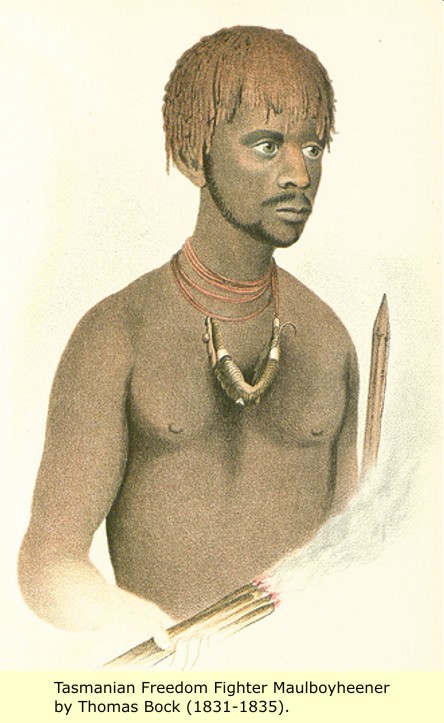 |
Their capture was effected by an overwhelming party of soldiers, police, settlers and black trackers near Anderson's Inlet, not far from Cape Patterson. During the 8 weeks of their roaming, reports of their feats sent a shiver down the spine of the Europeans who were living in Melbourne and its surrounds. They arrived in chains under military escort in Melbourne on 21st November 1841. All 5 were charged with murder and appeared in court before Judge Willis on the 20th December 1841. The jury delivered a verdict after half an hour finding the men guilty of murder, and the women not guilty. The jury made a very strong plea for clemency for the men 'on account of general good character and the peculiar circumstances under which they are placed'.
The next day Judge Willis sentenced the 2 men to death and
the 3 women were discharged into Robinson's care. The jury's plea for
mercy was rejected by the Executive Council of New South Wales. On the
20th January 1842 Tunnerminnerwait and Maulboyheenner were led to the
scaffold, where the current RMIT building is located. Here they were
hanged watched by a crowd of about 5,000. The first public judicial
execution in Melbourne. Tunnerminnerwait and Maulboyheenner were buried outside the Melbourne cemetery (under the current Victoria Market, Melbourne).
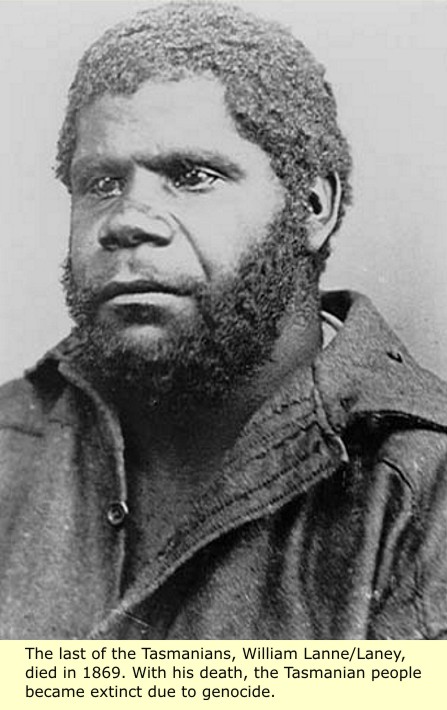 |
The last of the Tasmanians, William Lanne or Laney, died in 1869. Dr. Lodewyk Crowther removed his head in the name of science at the Colonial Hospital, and made a tobacco pouch out of his scrotum. The Tasmanians are now Extinct! (Of course, the fate of the Tasmanians is rendered almost insignificant by that of the approximately 90 million Black and Mongol original Americans who were killed or died of European diseases between 1492 and 1650). As it turns out, Blacks have the LEAST susceptibility to disease of all Humans. So clearly, the "diseases killed the original Americans" story, was just one of many Albino lies! See this study for proof of this claim:
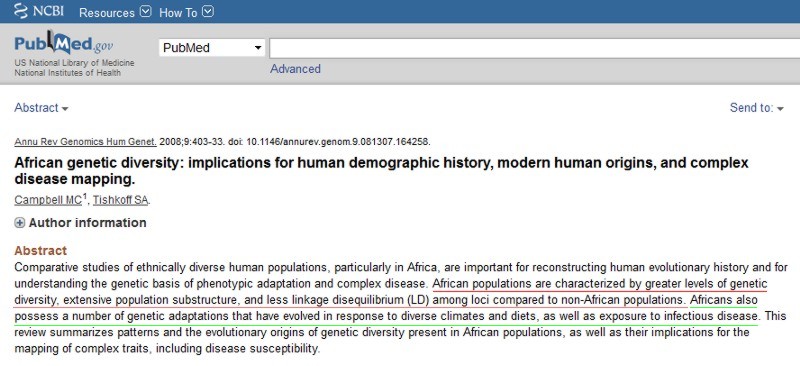 |


Note: the name “New Guinea” was given to the Island by Capt. Cook, because they were amazed at how similar the people of the Island looked, to the people of the East African nation of Guinea.
WIKI:
Papuan is an umbrella term for the various indigenous peoples of New Guinea and neighbouring islands, speakers of the Papuan languages. They are often distinguished ethnically and linguistically from Austronesians, speakers of a language family introduced into New Guinea about three thousand years ago.
Haplogroup M-P256 is a Y-chromosome DNA haplogroup.
M-P256 is a descendant haplogroup of haplogroup MS, and is believed to have first appeared between 32,000 and 47,000 years ago. M-P256 is the most frequently occurring Y-chromosome haplogroup in Western New Guinea (Kayser 2003).
Haplogroup S-M230, also known as Haplogroup K2b1a4, is a Y-chromosome DNA haplogroup. It is the largest subclade of Haplogroup S-P405 (K2b1a). Haplogroup S-M230 is commonly found among populations of the highlands of Papua New Guinea (Kayser 2003). It is also found at lower frequencies in adjacent parts of Indonesia and Melanesia.
In a 2005 study of ASPM gene variants, Mekel-Bobrov et al. found that the Papuan people have among the highest rate of the newly evolved ASPM haplogroup D, at 59.4% occurrence of the approximately 6,000-year-old allele. While it is not yet known exactly what selective advantage is provided by this gene variant, the haplogroup D allele is thought to be positively selected in populations and to confer some substantial advantage that has caused its frequency to rapidly increase.
According to various studies, Papuan people, other Melanesians, and Aboriginal Australians are the only known modern humans whose prehistoric ancestors interbred with the Denisova hominin, with whom they share 3–5% of their genome. It appears that Aboriginal Australians made it to South America, where Denisovian genes can be found today. Aboriginal Australian skulls and linguistic traits have been found in South America.
ASPM (gene)
Abnormal spindle-like microcephaly-associated protein also known as abnormal spindle protein homolog or Asp homolog is a protein that in humans is encoded by the ASPM gene. ASPM is located on chromosome 1, band q31 (1q31). Defective forms of the ASPM gene are associated with autosomal recessive primary microcephaly.
A new allele (version) of ASPM appeared sometime between 14,100 and 500 years ago with a mean estimate of 5,800 years ago. The new allele has a frequency of about 50% in populations of the Middle East and Europe, it is less frequent in East Asia, and has low frequencies among Sub-Saharan African populations. It is also found with an unusually high percentage among the people of Papua New Guinea, with a 59.4% occurrence.
The mean estimated age of the ASPM allele of 5,800 years ago, roughly correlates with the development of written language, spread of agriculture and development of cities. Currently, two alleles of this gene exist: the older (pre-5,800 years ago) and the newer (post-5,800 years ago). About 10% of humans have two copies of the new ASPM allele, while about 50% have two copies of the old allele. The other 40% of humans have one copy of each. Of those with an instance of the new allele, 50% of them are an identical copy suggesting a highly rapid spread from the original mutation. According to a hypothesis called a "selective sweep", the rapid spread of a mutation (such as the new ASPM) through the population indicates that the mutation is somehow advantageous to the individual.
Testing the IQ of those with and without new ASPM allele has shown no difference in average IQ, providing no evidence to support the notion that the gene increases intelligence. However statistical analysis has shown that the older forms of the gene are found more heavily in populations that speak tonal languages like Chinese or many Sub-Saharan African languages.
Denisovans or Denisova hominins are a extinct species of human in the genus Homo. In March 2010, scientists announced the discovery of a finger bone fragment of a juvenile female who lived about 41,000 years ago, found in the remote Denisova Cave in the Altai Mountains in Siberia, a cave which has also been inhabited by Neanderthals and modern humans. Two teeth and a toe bone belonging to different members of the same population have since been reported.
Analysis of the mitochondrial DNA (mtDNA) of the finger bone showed it to be genetically distinct from the mtDNAs of Neanderthals and modern humans. Subsequent study of the nuclear genome from this specimen suggests that this group shares a common origin with Neanderthals, that they ranged from Siberia to Southeast Asia, and that they lived among and interbred with the ancestors of some present-day modern humans, with about 3% to 5% of the DNA of Melanesians and Aboriginal Australians deriving from Denisovans. DNA discovered in Spain suggests that Denisovans at some point resided in Western Europe, where Neanderthals were thought to be the only inhabitants. A comparison with the genome of a Neanderthal from the same cave revealed significant local interbreeding, with local Neanderthal DNA representing 17% of the Denisovan genome, while evidence was also detected of interbreeding with an as yet unidentified ancient human lineage. Similar analysis of a toe bone discovered in 2011 is underway, while analysis of DNA from two teeth found in layers different from the finger bone revealed an unexpected degree of mtDNA divergence among Denisovans. In 2013, mitochondrial DNA from a 400,000-year-old hominin femur bone from Spain, which had been seen as either Neanderthal or Homo heidelbergensis, was found to be closer to Denisovan mtDNA than to Neanderthal mtDNA.
An international team of scientists has sequenced the genome of an archaic Siberian girl 31 times over, using a new method that amplifies single strands of DNA. The sequencing is so complete that researchers have as sharp a picture of this ancient genome as they would of a living person's, revealing, for example that the girl had brown eyes, hair, and skin. In the paper, which has been published in the journal Science, Matthias Meyer of the Max Planck Institute for Evolutionary Anthropology, Germany. The paper suggests that the ancient Denisovans spilt from the ancestors of the modern human between 170,000 and 700,000 years ago. Although the already low Denisovan population dwindled significantly around 400,000 years ago, the same time as our ancestral Homo sapiens' population boomed, Denisovan DNA is present in the indigenous populations of Papua New Guinea (around three percent is shared), Fiji and Australia. Han and Dai populations on mainland China have trace similarities with Denisovan DNA. The find adds weight to the theory that ancient humans such as the Neanderthal and the Denisovan interbred with Homo sapiens, particularly in the case of the Papuan DNA, which revealed interesting genetic patterns suggesting male Denisovans interbred with female modern humans.
One of the most unusual finds of the study was that modern day East Asians actually have more Neanderthal DNA than modern Europeans - this is unexpected, because most Neanderthal fossils have been found in Europe.
"We have determined that one percent of the DNA in a European matches the DNA of the Neanderthal," said Meyer. "Surprisingly, the 1.8 percent match with East Asians is significantly higher, although the centre of Neanderthal settlements was mainly in Europe. Therefore, Homo sapiens and Neanderthals possibly intermingled more frequently in Asia than in Europe."
The "First" (OOA) migration, circa 60,000 B.C, saw Blacks
with straight hair, taking a route along the coast of Asia, and then
"Island hopping" across the Indian Ocean to Australia - the Australian
Aborigine.
Current evidence indicates that the Papuans (who constitute the majority of the island's peoples) are descended from the earliest human inhabitants of New Guinea. These original inhabitants first arrived in New Guinea at a time when the island was connected to the Australian continent via a land bridge, forming the landmass known as Sahul. These peoples had made the (shortened) sea-crossing from the islands of Wallacea and Sundaland (the present Malay Archipelago) by at least 40,000 years ago, subsequent to the dispersal of peoples from Africa (circa) 50,000 - 70,000 years ago.
The ancestral Austronesian peoples are believed to have
arrived considerably later, approximately 3,500 years ago, as part of a
gradual seafaring
migration from Southeast Asia, possibly
originating in Taiwan. Austronesian-speaking peoples colonized many of
the offshore islands to the north and east of New Guinea, such as New
Ireland and New Britain, with settlements also on the coastal fringes
of the main island in places. Human habitation of New Guinea over tens
of thousands of years has led to a great deal of diversity, which was
further increased by the later arrival of the Austronesians and the
more recent history of European and Asian settlement through events
like transmigration.
Taiwan was joined to the Asian mainland in the Late Pleistocene, until sea levels rose about 10,000 years ago. Fragmentary human remains have been found on the island, dated 20,000 to 30,000 years ago, as well as later artifacts of a Paleolithic culture. More than 4,000 years ago farmers from mainland China, believed to be the ancestors of current Taiwanese aborigines, settled on Taiwan. Their languages belong to the Austronesian language family, which also includes the Malayo-Polynesian languages spanning a huge area from Madagascar to Easter Island. The aboriginal languages on Taiwan show much greater diversity than the rest of Austronesian put together, leading linguists to propose Taiwan as the Urheimat of the family, from which sea-faring peoples dispersed across southeast Asia and the Pacific and Indian Oceans.
The earliest evidence of inhabitation of Taiwan dates back to the late Paleolithic era. The island of Taiwan was mainly inhabited by Taiwanese aborigines before being colonized in the 17th century by the Dutch and the Spanish Empire. The first Han Chinese polity on Taiwan began when Koxinga's troops defeated Dutch forces and established the Kingdom of Tungning. The island was subsequently ruled by the Qing Dynasty after the kingdom's defeat in the Battle of Penghu in 1683, a period that lasted for over 200 years. Following Japan's victory over the Qing Dynasty in the first Sino-Japanese war, Taiwan was ceded to Japan under the Treaty of Shimonoseki in 1895.
Taiwanese aborigines is the term commonly applied in reference to the indigenous peoples of Taiwan. Recent research suggests their ancestors may have been living on the islands for approximately 8,000 years before major Han (Mongol) Chinese immigration began in the 17th century. Taiwanese aborigines are Austronesian peoples, with linguistic and genetic ties to other Austronesian ethnic groups, such as peoples of the Philippines, Malaysia, Indonesia, Madagascar, Polynesia, and Oceania. Today, about 98% of Taiwan's population is of Han Chinese ethnicity, with the rest being distant mulattoes of the Taiwanese aborigines showing varying levels of Chinese, Japanese, Spanish, and Dutch admixture.
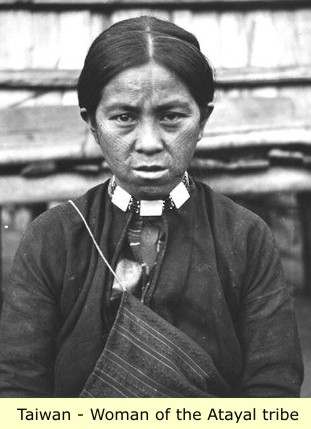 |
 |
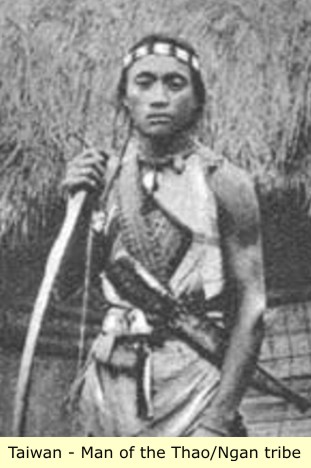 |
 |
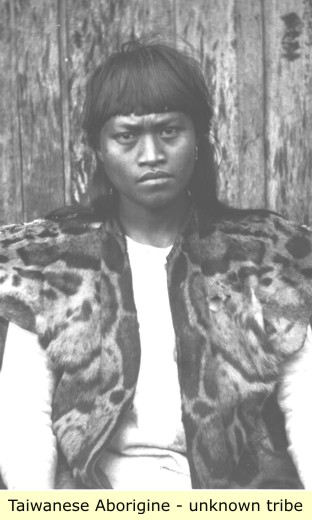 |
 |
 |
The Austronesian-speaking peoples are various populations in
Southeast Asia and Oceania that speak languages of the Austronesian
family. They include Taiwanese aborigines; the majority ethnic groups
of East Timor, Indonesia, Malaysia, the Philippines, Brunei,
Madagascar, Micronesia, and Polynesia, as well as the Polynesian
peoples of New Zealand and Hawaii, and the non-Papuan people of
Melanesia. They are also found in Singapore, the Pattani region of
Thailand, and the Cham areas of Vietnam (remnants of the Champa kingdom
which covered central and southern Vietnam), Cambodia, and Hainan,
China. The territories populated by Austronesian-speaking peoples are
known collectively as Austronesia. Polynesians are believed to have
spread from Taiwan across the Pacific with the Lapita people.
For the past 100 years or so, the Saisiyat tribe of Taiwan has performed the songs and rites of a festival to bring good harvests, ward off bad luck and keep alive the spirit of a race of people who are said to have preceded all others in Taiwan, and which they exterminated.
In fact, the short, black men the festival celebrates are
one of the most ancient types of modern humans on this planet and their
kin are still survive in Asia today. They are said to be diminutive
Africoids and are variously called Pygmies, Negritos and Aeta. They are
found in the Philippines, northern Malaysia, Thailand, Sumatra in
Indonesia and other places.
Chinese historians called them "black
dwarfs" in the Three Kingdoms period (AD 220 to AD 280) and they were
still to be found in China during the Qing dynasty (1644 to 1911). In
Taiwan they were called the "Little Black People" and, apart from being
diminutive, they were also said to be broad-nosed and dark-skinned with
curly hair.
Is a term applied to an ancient Pacific Ocean archaeological
culture which is believed by many archaeologists to be the common
ancestor of several cultures in Polynesia, Micronesia, and some coastal
areas of Melanesia. The archaeological culture and its characteristic
geometric dentate-stamped pottery are named after the type site where
it was first uncovered in the Foué peninsula on Grande Terre, the main
island of New Caledonia. An ultimate Southeast Asian origin of the
Lapita complex is assumed by most scholars, perhaps originating from
the Austronesians in Taiwan or southern China some 5,000 to 6,000 years
ago. This Neolithic dispersal was driven by a rapid population growth
in east and southeast Asia (Formosa), and has often been called 'the
express-train to Polynesia'. Burial pottery similar to "red slip"
pottery of Taiwan, as well as detailed linguistic evidence, seem to
lend support to this theory. The orthodox view argued for by people
like Roger Green and Peter Bellwood argues for a Triple-I model where
Lapita arose from this Austronesian expansion through a process of
intrusion into new territories, innovation of new technologies (such as
the Outrigger Canoe), and integration with the existing populations.
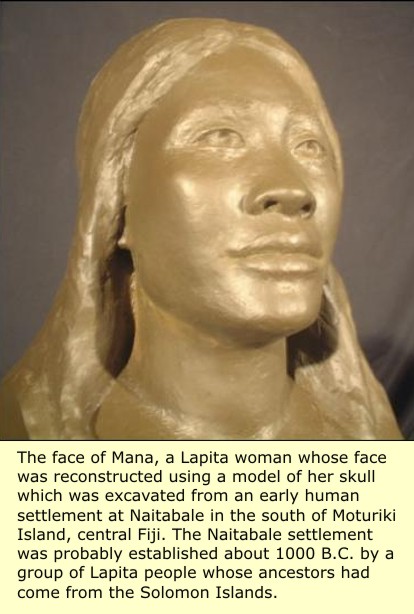 |
An element in the ancestry of Austronesian-speaking peoples, the one which carried their ancestral language, originated on the island of Taiwan following the migration of pre-Austronesian-speaking peoples from continental Asia approximately 10,000-6000 BC.
According to mainstream "out-of-Taiwan model", a large-scale Austronesian expansion began around 5000-2500 BC. Population growth primarily fueled this migration. These first settlers may have landed in northern Luzon in the archipelago of the Philippines, intermingling with the earlier Australo-Melanesian population who had inhabited the islands since about 23,000 years earlier. Over the next thousand years, Austronesian peoples migrated southeast to the rest of the Philippines, and into the islands of the Celebes Sea, Borneo, and Indonesia. The Austronesian peoples of Maritime Southeast Asia sailed eastward, and spread to the islands of Melanesia and Micronesia between 1200 BC and 500 AD respectively. The Austronesian inhabitants that spread westward through Maritime Southeast Asia had reached some parts of mainland Southeast Asia, and later on Madagascar.
Sailing from Melanesia, and Micronesia, the Austronesian peoples discovered Polynesia by 1000 BC. These people settled most of the Pacific Islands. They had settled Easter Island by 300 AD, Hawaii by 400 AD, and into New Zealand by 800 AD. In the Indian Ocean they sailed west from Maritime Southeast Asia; the Austronesian peoples reached Madagascar by 0-500 AD.
The Taiwan hypothesis is mainly based on linguistic and
partly archaeological evidence, and says nothing about genes or the
oldest migrations to East Asia and the initial colonizing of the area,
only about the migration that led to the spread of the Austronesian
languages.
In the americas, analysis of available data suggests that the chronology of migration to the Americas goes something like this:
20,000 B.C. and well Before – Australoids were coming in, from the south.
20,000 B.C. to 7,000 B.C. – Polynesians were coming in, from the south.
While all the new evidence establishes that Australoids and Polynesians were the first inhabitants of the Americas, it does NOT explain how they got here! The Northern route across the Bering straits somehow doesn’t seem to work for them. These are more logical theories of their migration.
 |
 |
An area of debate revolves on just how far south Polynesians actually managed to get. There is some material evidence of Polynesian visits to some of the subantarctic islands to the south of New Zealand, which are outside Polynesia proper. Shards of pottery has been found in the Antipodes Islands, and is now in the Te Papa museum in Wellington, and there are also remains of a Polynesian settlement dating back to the 13th century on Enderby Island in the Auckland Islands.
There is legend that Ui-te-Rangiora, believed to have been a 7th-century Māori navigator from the island of Rarotonga. In the year 650, led a fleet of Waka Tīwai (War Canoes) south until they reached, "a place of bitter cold where rock-like structures rose from a solid sea", The brief description appears to match the Ross Ice Shelf or possibly the Antarctic mainland, but may just be a description of icebergs and Pack Ice found in the Southern Ocean
 |
Polynesia is a Latinization of Fr. polynésie, coined 1756 by de Brosses from Gk. polys "many" (see poly-) + nesos "island." The term "Polynesia" was first used in 1756 by French writer Charles de Brosses, and originally applied to all the islands of the Pacific. But in 1831, Jules Dumont d'Urville proposed a restriction on its use during a lecture to the Geographical Society of Paris. His intention was clearly to distinguish the pure Blacks of the Pacific from the mulatto populations.
The Polynesian people are considered to be by linguistic, archaeological and human genetic ancestry a subset of the sea-migrating Austronesian people and tracing Polynesian languages places their prehistoric origins, ultimately, in Taiwan.
At about 2000 B.C. speakers of Austronesian languages began spreading from Taiwan into Island Southeast Asia. Their speech of the time was not clearly related to Chinese speech of the time and Chinese speakers were all further north on the mainland at the turn of the second and third millennia BC. Taiwan was only later Sinicized via large-scale immigration accompanied by much assimilation of the Austronesian speaking indigenous people during the 17th century AD.
Main Polynesia
American Samoa (overseas United States territory)
Cook Islands (self-governing state in free association with New Zealand)
Easter Island (called Rapa Nui in Rapa Nui, politically part of Chile)
French Polynesia (overseas country, a collectivity of France)
Hawaii (a state of the United States)
New Zealand (independent nation)
Niue (self-governing state in free association with New Zealand)
Norfolk Island (an Australian External Territory)
 |
Pitcairn Islands (a British Overseas Territory)
Samoa (independent nation)
Tokelau (overseas dependency of New Zealand)
Tonga (independent nation)
Tuvalu (independent nation)
Wallis and Futuna (collectivity of France)
Rotuma
Polynesian outliers in Melanesia
Anuta (in the Solomon Islands)
Mele (in Vanuatu)
Bellona Island (in the Solomon Islands)
Emae (in Vanuatu)
Nuguria (in Papua New Guinea)
Nukumanu (in Papua New Guinea)
Ontong Java (in the Solomon Islands)
Pileni (in the Solomon Islands)
Rennell (in the Solomon Islands)
Sikaiana (in the Solomon Islands)
Takuu (in Papua New Guinea)
Tikopia (in the Solomon Islands)
Fiji Island
In Micronesia
Kapingamarangi (in the Federated States of Micronesia)
Nukuoro (in the Federated States of Micronesia)
Subantarctic Islands
Antipodes Islands
Auckland Islands (the most southerly known evidence of Polynesian settlement)
Black Chinese |
The Chams of Vietnam |
The Mani of Thailand |
||
 |
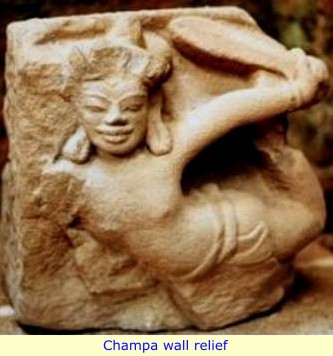 |
 |
Negritos |
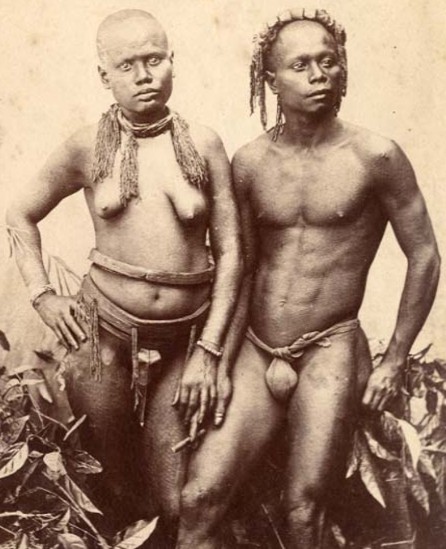 |
 |
Wiki:
New Zealand was one of the last major landmasses settled by humans. Radiocarbon dating, evidence of deforestation, and mitochondrial DNA variability within Māori populations; suggest New Zealand was first settled by Eastern Polynesians between 1250 and 1300, concluding a long series of voyages through the southern Pacific islands. Over the centuries that followed, these settlers developed a distinct culture now known as Māori. The population was divided into iwi (tribes) and hapū (subtribes) who would sometimes cooperate, sometimes compete and sometimes fight against each other. At some point, a group of Māori migrated to the Chatham Islands (which they named Rēkohu) where they developed their distinct Moriori culture. The Moriori population was all but wiped out between 1835 and 1862, largely because of Taranaki Māori invasion and enslavement in the 1830s, although European diseases also contributed.
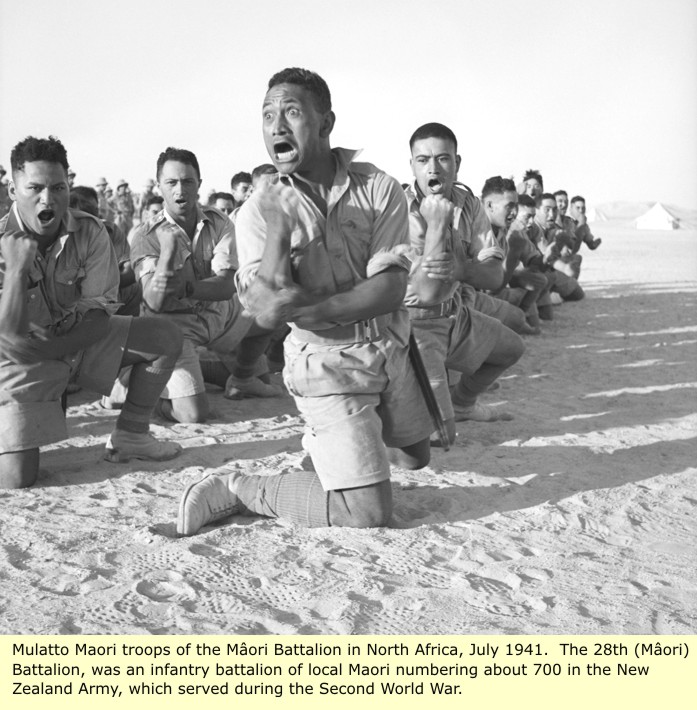 |
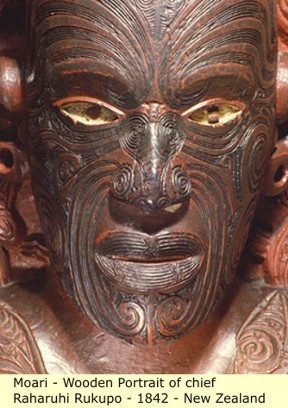

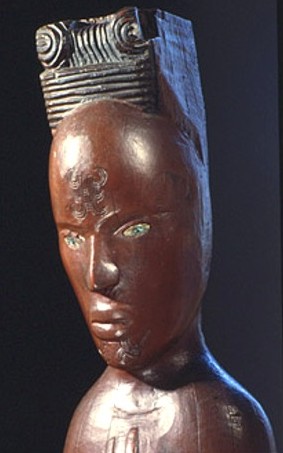
The islands settled by the Papuans are known collectively as Melanesia, which includes Papua New Guinea, the Solomon Islands, Vanuatu, and New Caledonia. Fiji is the melting pot of the Melanesians to the west and the Polynesians to the east.


 |
The above explanation and definition is of
course the “Innocent” one. The “Modern” meaning of the term
“Polynesian” is actually dripping with vile Albino racism. Today, the
Albinos have settled on the term Polynesians to indicate and
differentiate the Non-Black populations of the Pacific Islands.
Of course what they are really trying to do is simply more of their continuing efforts to create a fantasy world where there are few Blacks, and they (Albinos) are the majority population of the World: and where their Mulattoes “are passed off” as the “Original” people in North Africa, Arabia, The Middle-East, Latin America, the Caribbean, and of course the Pacific. And as usual, Albinos lies are real easy to debunk, for those willing to spend a little time to expose the truth.
Etymology of Polynesia: From Ancient Greek (polús, “many”) + (nêsos, “island”); according to Moon Handbooks Tahiti, "the term Polynesia was coined by Charles de Brosses in 1756 and applied to ALL the Pacific islands.
Following his expedition in 1829,
Frenchman Jules Dumont d'Urville invented the terms Malaisia
(Malaysia), Micronesia and Melanesia, distinguishing these Pacific
cultures and island groups from Polynesia.
Micronesia:
from Greek: mikrós "small" and Greek: nêsos "island") is a subregion of
Oceania, composed of thousands of small islands in the western Pacific
Ocean.
Malaysia: A country of Southeast Asia consisting of the southern Malay Peninsula and the northern part of the island of Borneo
So in reality Jules Dumont d'Urville was simply trying to do what Albinos always try to do: in this case, claim the Pacific Islands with large Mulatto populations as being Non-Black – implying that the original people were also Non-Black.
Thankfully, some modern populations
are more interested in being considered White, than in claiming to be
related to the original people of the land. Thus in Puerto Rico where
the original people were the Black Taíno people: according to census
figures: 76% of the population describe themselves as White – actually
they’re Mulatto, but why quibble, at least they're not claiming to be
descendants of the Taino.
 |
"Minority" and "Diversity"What those words are meant to implyas relates to the World Population of Humans.
Anyone familiar with American "Race-Speak" knows that their favorite words of condescension are "Minority" and "Diversity" both of which the Mongols are now mimicking . Both imply that Blacks are out of the mainstream, outliers, or the "Others". Of course that only proves what we always say: the less Melanin they have, the more delusional they become. Clearly what they need is the "Cold Water" in the face of "Facts and Figures" aka reality. Do
this: Google – “White World Population” Being very care with the
syntax, remember you are asking an Albino source for truth. Naturally
they will find any number of ways to lie to you if you use the wrong
search words. Answer from Wikipedia section titled “White People”: 850,000,000+ (which is about) 11.5% of the total world population (world population of 7.5 - 7.7 billion). Facts and Figures: The current population of Japan is 126,766,566 as of 2019, based on Worldometers elaboration of the latest United Nations data. For a total East-Asian Mongol population of 1,637,452,415 people: which is about 21% of the Human population.The current world population is 7.7 billion as of September 2019 according to the most recent United Nations estimates elaborated by Worldometers. Here is the “Cold Water” of reality Albinos and Mongols: “YOUR” 21% + 11.5% = 32.5% of the Human population.
|
The Trump Presidency
As to Trump: because of his disrespectful use of the word Lynching in reference to his impeachment hearings: the Trump Presidency has precipitated renewed calls for cleansing the United States of the Sickness of Racism. Only problem is, how can you get rid of something that you have not clearly identified or defined? To the point, what is racism really - at its core? We all know the symptoms of racism (Acts of violence, denial of rights, disenfranchisement from society and commerce etc.), but what is the reason for those acts? An ignorant Negro might say "well I guess they just don't like Black people", but of course that's just simple-minded nonsense. To understand the reasons for racism, one need only examine the acts of racism, and analyze the motivations. Example: Emmett Louis Till was a 14-year-old Black American Boy who was lynched in Mississippi in 1955 after being accused of offending a white woman in her family's grocery store. The Albino Mob came and took him away from his great-uncle's house; they beat and mutilated him, before shooting him in the head and sinking his body in the Tallahatchie River. Today: In 2007 an Emmett Till memorial sign was put up on the place where his body was found in 1955. Soon after being put up, the sign was riddled with bullet holes. The bullet riddled sign was replaced, but the new sign was soon bullet riddled too. Another new sign was put up, but the same thing happened again. Until finally in October 2019 a new sign, which is the fourth to replace others that were vandalized, was installed, it is made of steel and weighs 500 pounds. Clearly there is more to racism than simple dislike or mental illness. After all, even the sickest child, who enjoys plucking the wings off Butterfly's and mutilating small animals; eventually moves on to other things, sometimes worst things, but he moves on. And his offspring is not necessarily the same, because his defects are not necessarily hereditary over his generations - as racism is. Therefore
racism is not truly about sickness: looking at the defacement of the
Till Memorial: doesn't that remind you mostly of “Deep Petulant
Resentment”? That is not the act of Superiors, that is the act of
people who feel themselves Inferior, and are angry that they are. And
as we all know, when we cannot stand ourselves, we take it out on
others. See the Albino suicide rate chart in another section. Note that the Japanese and Chinese workers on this page are all “Dark Skinned”. That is because Mongols are a Mulatto race, but they are not only “Yellow”, they are also White (Albino) and Black: Black + Albino = Yellow. Interestingly;
Albino Mongols in China have created the societal myth that the reason
there are non-White Chinese, is because the “Dark” ones are a lower
class who are dark because they have to work in the Sun.
|
The United Nations Declaration on the Rights of Indigenous Peoples (UNDRIP), says in part:Article 7:
The
declaration was adopted by the General Assembly on Thursday, 13
September 2007, by a majority of 144 states in favor, with 4 votes
against: those against were Australia, Canada, New Zealand and the
United States: all of which had institutionally committed those very
crimes against Indigenous Peoples since the arrival of the Albino
people. |
Wiki: The earliest habitation supported by archaeological evidence dates to as early as 300 CE, probably by Polynesian settlers from the Marquesas Islands, followed by a second wave of migration from Raiatea and Bora Bora in the 11th century. There is a great deal of debate regarding the actual date of discovery and habitation.Some archaeologists and historians believe that an early settlement from the Marquesas and a later wave of immigrants from Tahiti circa 1000 CE introduced a new line of high chiefs, the kapu system, the practice of human sacrifice and the building of heiau. This later immigration is detailed in Hawaiian mythology (moʻolelo) about Paʻao. Other authors argue that there is no archaeological or linguistic evidence for a later influx of Tahitian settlers, and that Paʻao must be regarded as a myth.
Regardless of the question of Paʻao, historians agree that the history of the islands was marked by a slow but steady growth in population and the size of the chiefdoms, which grew to encompass whole islands. Local chiefs, called aliʻi, ruled their settlements and launched wars to extend their sway and defend their communities from predatory rivals. Ancient Hawaiʻi was a caste-based society much like that of the Hindus in India.
It is possible that Spanish explorers arrived in the Hawaiian Islands in the 16th century, two centuries before Captain James Cook's first documented visit in 1778. Ruy López de Villalobos commanded a fleet of six ships that left Acapulco in 1542 bound for the Philippines with a Spanish sailor named Juan Gaetano aboard as pilot. Depending on the interpretation, Gaetano's reports seemed to describe the encounter with either Hawaiʻi or the Marshall Islands. If the crew had indeed spotted Hawaiʻi, Gaetano would have been the first European to see the islands.
Some scholars have dismissed these claims due to a lack of credibility. However, Spanish archives contain a chart that depicts islands in the latitude of Hawaiʻi but with the longitude ten degrees east of the Islands. In this manuscript, the island of Maui is named La Desgraciada (The Unfortunate Island), and what appears to be the Hawaii Island is named La Mesa. Islands resembling Kahoolawe, Lanai, and Molokai are named Los Monjes (The Monks). For two and a half centuries Spanish galleons crossed the Pacific along a route that passed south of Hawaiʻi on their way to Manila. The exact route was kept secret to protect the Spanish trade monopoly against competing powers.
The 1778 arrival of British explorer James Cook was Hawaii's first documented contact with European explorers. Cook named the islands the Sandwich Islands in honor of his sponsor John Montagu, 4th Earl of Sandwich. He published the islands' location and rendered the native name as Owyhee. This spelling lives on in Owyhee County, Idaho, after three Hawaiian members of a trapping party went missing in that area.
Cook visited the islands twice. Upon his departure during his second visit in 1779, a quarrel ensued after Cook took temple idols and fencing as "firewood", and a minor chief and his men took a ship's boat. Cook then abducted the King of the Big Island of Hawaiʻi, Kalaniʻōpuʻu, and held him for ransom aboard his ship for the return of Cook's boat, a tactic that had worked for Cook in Tahiti and other islands. Kalaniʻōpuʻu's supporters fought back, killing Cook and four marines as Cook's party retreated to their ship on the beach.
After Cook's visit and the publication of several books relating his voyages, the Hawaiian islands received many European visitors—explorers, traders, and eventually whalers who found the islands to be a convenient harbor and source of supplies. Early British influence can be seen in the design of the flag of Hawaiʻi, which bears the British Union Jack in the top-left corner.
 |
The Gannenmono - or how the Japanese came to be in Black HawaiiIn 1866, Eugene Miller Van Reed, a Dutch American, went to Japan as a representative of the Hawaiian Kingdom. He failed to establish a formal Hawaii-Japan relationship, but continued to stay there as a merchant and obtained a permission of Japanese emigration from the Edo Shogunate. As he started recruiting, the new Meiji Government that came into power in 1867, the first year of the Meiji period, nullified all the Edo Shogunate's treaties. (One of the reasons of the new government's rejection is said to be the rumor that Van Reed was engaged in slave trade). There
were 142 men and 6 women in this initial group, so many of them married
Hawaiians after they arrived in Hawaii. They worked on sugar
plantations on Oahu, Maui, Kauai, and Lanai. Two or three months after
arriving, many complained of contract violations since the working
conditions and pay did not match with what they were promised. At least
four of the six women and 50 men returned to Japan in 1870. Seven had
died before their contracts ended. Among the Gannenmono were several
people who would become legends among the Japanese Americans in Hawaii:
Tomitarō Makino from Miyagi, the leader of the group; the youngest
Ichigorō Ishimura, 13 years old; Sentarō Ishii, a samurai from Okayama,
who was 102 years old when he died in Maui; Tokujirō "Toko" Satō from
Tokyo, who lived in Waipio Valley with his Hawaiian wife, Clara; and
Tarō Andō, who would become Japan's first consul general to the Kingdom
of Hawaii. |
 |
 |
 |
According to the 1980 census, there were 118,000 "Part-Hawaiians"in the Hawaiian Islands. As compared to 332,000 whites and 240,000 Japanese.See the 2005 numbers below |



The birth date of King Kamehameha I, also called Kamehameha the Great, is not known. According to legend, there was a bright star in the sky when he was born; this may have been Halley's comet, which was visible in 1758. Believing that the star portended the birth of a fearsome conqueror, a chief named Alapai tried to have the baby killed, but the child was secretly rescued and brought up in isolation. Kamehameha means "the lonely one."
As an adult, Kamehameha became chief of the northern half of the island of Hawaii. Eventually he brought the entire island under his reign. The other Hawaiian Islands were controlled by other kings, but Kamehameha conquered and united them, becoming ruler of all the islands by 1810.
Although the king didn't allow non-Hawaiians to interfere in island politics, he was accepting of foreigners and their innovations, such as muskets and nails. During his reign Hawaii became an important center of the fur and sandalwood trades. Pineapples were first brought to Hawaii from Spain in 1813, and coffee was first planted in the islands in 1818, the year before Kamehameha I died. (Macadamia nut trees weren't introduced until 1892).
In 1883 a statue of King Kamehameha I was unveiled in Honolulu by King David Kalakaua. It was a duplicate; the original, cast by Thomas Gould, had been lost at sea. It was eventually recovered and placed near Kamehameha's birthplace. Another duplicate can be found in the Statuary Hall in Washington DC.
 |
 |
 |
 |
 |
 |
 After
Kamehameha the Great's death in 1819, his 22-year-old son Liholiho
became King Kamehameha II. However, his stepmother, Queen Kaahumanu,
was the power behind the throne.
After
Kamehameha the Great's death in 1819, his 22-year-old son Liholiho
became King Kamehameha II. However, his stepmother, Queen Kaahumanu,
was the power behind the throne.
The first Christian missionaries came to Hawaii shortly after Kamehameha I's death. Queen Kaahumanu converted to their faith. (Kamehameha II did not.) At that time Hawaiians wore little clothing, but the missionaries convinced the queen to adopt a loose, cool version of a Victorian gown. It was so much easier to wear than most Victorian gowns that Hawaiian women exclaimed, "Holo! Ku!" meaning, "We can run in it! We can stand!" So the gown was called the holoku.
Eventually Christian missionaries developed the Hawaiian alphabet and made some changes. The name Kamehameha was originally Tamehameha; the missionaries are said to have changed the T to K.
As Hawaii became a Christian nation, Hawaiian royal women were growing extremely self-conscious about their Hawaiian looks. They were uncomfortable with their dark skin color, broad features, and Rubenesque bodies in which their mothers and grandmothers had been so much at home.
Their very physical manifestation was a rude and constant reminder of the fact that no matter how Westernized of manner they might be, they would always be seen first and foremost as a Hawaiian squaw. By the close of the nineteenth century, royal women were going in two different directions in response to their looks, and thus inter-marriages between the two races began.
In 1824, while visiting Hawaii, Liholiho and members of his party came down with measles, for which Hawaiians had no immunity. Liholiho's favorite wife died. Heartbroken, Liholiho also died. Their bodies were returned to Hawaii for burial, and in 1825 Liholiho's brother Kauikeaouli, who was still a child, became Kamehameha III.
Queen Kaahumanu served as Kamehameha III's regent until her death in 1832. She was a strong and cunning ruler. Under her influence Kamehameha III became a Christian and banned traditional Hawaiian beliefs and practices, such as hula.
In 1839 Kamehameha III guaranteed religious freedom to the people of Hawaii. He was also responsible for transforming the kingdom into a modern constitutional monarchy. The 1840 constitution gave male citizens the vote and established a representative legislature. By 1843 France, England and the United States had recognized Hawaii as an independent nation.
By now Hawaii was a center of the whaling industry. Commercial sugar cane production began in Hawaii in 1835, and became especially important to the economy after whaling declined in the 1860s. Hawaii's prosperity made it desirable to both Americans and Europeans. Kamehameha III offered to place his islands under Queen Victoria's protection, but she refused for political reasons. In the 1840s America tried to annex Hawaii, but Kamehameha III thwarted this effort.
 |

Kamehameha III died in December 1854 and was succeeded by his nephew (and adopted son) Alexander, who reigned under the name Kamehameha IV. To prevent the annexation of Hawaii by the United States, he developed diplomatic and trade relations with other countries. He also tried to slow the influence of Christian missionaries.
European diseases were taking a serious toll on native Hawaiians. Many native Hawaiians were dying and others objected to working on sugar plantations, therefore workers flooded into the islands from other Asian countries. This is why modern-day Hawaii has such a diverse Mongol population (mainly Chinese and Japanese).
Kamehameha IV's wife was named Queen Emma. Her father was a chief, George Naea; her mother, Fanny Kekelaokalani Young, was the daughter of Kamehameha I's niece Ka'oana'eha and the king's British counselor John Young. Emma was adopted by her aunt and uncle Grace and Thomas Rooke, who had no children of their own. (Grace Kamaikui Rooke was Emma's maternal aunt.) Emma spoke both Hawaiian and English, and was a good musician and horsewoman. Before her marriage, some people said she was not worthy to be queen because she was partly white, but she became a popular queen. She helped establish a hospital to help combat the diseases devastating Hawaiians. It was named Queen's Hospital in her honor and still stands in Honolulu.

Alexander and Emma had one son, Prince Albert - the last child ever born to a monarch of Hawaii. In 1862 Albert died of a brain fever. He was four. The king and queen were devastated by their son's death. Queen Emma spent four days sitting beside his grave. To honor Albert the king gave Emma a new name, Kaleleokalani, meaning "The flight of the heavenly chief." When the King died the next year at the age of 29, supposedly of asthma and a broken heart, Queen Emma changed her name to the plural Kaleleonalani, "flight of the heavenly chiefs." (According to rumor, Kamehameha IV was poisoned, but this has never been proven.)
Kamehameha IV's successor was his older brother Lot, who reigned as King Kamehameha V. He replaced the constitution with one that gave him more power, improved the balance of trade in Hawaii, and increased foreigners' power.
Lot was so fat at the end of his life that he couldn't leave his palace. He never married. He had once been engaged to Princess Bernice Pauahi, the last descendant of Kamehameha I, but she married businessman Charles Bishop instead. Kamehameha V tried to name Princess Bernice as his successor, but she didn't want to be queen. She is remembered as a philanthropist who left money to establish Kamehameha Schools for Hawaiian children.
 King
Kamehameha V died on December 11, 1872. He was the last king of the
Kamehameha dynasty. The Hawaiian legislature met to choose a new
monarch. Prince William Lunalilo, a descendant of a half brother of
Kamehameha I, was selected to be the new king.
King
Kamehameha V died on December 11, 1872. He was the last king of the
Kamehameha dynasty. The Hawaiian legislature met to choose a new
monarch. Prince William Lunalilo, a descendant of a half brother of
Kamehameha I, was selected to be the new king.
Lunalilo never married, although he was engaged for a while. He had many foreign advisors, but also had true concern for his own people. After a little over a year as king he died of consumption, leaving his estate to needy Hawaiians. Some believe that he, too, was poisoned because of his concern for the Hawaiian people.


Once again the Hawaiian legislature met to choose a new monarch. Dowager Queen Emma was considered, but David Kalakaua was chosen instead. Kalakaua was a chief. He was of royal blood, being descended from a cousin of Kamehameha the Great. He was well-educated, intelligent, and equally at home with Hawaiians and foreigners. But Queen Emma felt his lineage was less royal than hers, and her supporters were not pleased by the legislature's choice. They rioted and the British Marines had to be called in to control them.
In 1874 Kalakaua went to Washington to negotiate a reciprocal trade treaty. Hawaiian sugar poured into America and American money poured into Hawaii. But the king tried to increase the power of the monarchy, which threatened the interests of foreign businessmen. In 1887 several hundred foreigners formed a secret group called the Hawaiian League. Many members also belonged to the Honolulu Rifles, a militia organization. They intimidated Kalakaua into accepting a new constitution, known as the Bayonet Constitution. It stripped the king of power, making him a figurehead, and permitted white foreigners to vote in elections. Japanese, Chinese and other Asian residents of Hawaii were not permitted to vote.
In 1889 a man named Robert Wilcox led an uprising against the new constitution. The uprising was put down by Cabinet troops, but Wilcox became a hero to native Hawaiians. At his trial for conspiracy, an all-Hawaiian jury found him not guilty.
Kalakaua was accused of squandering Hawaiian money in order to live like European royals. During his long absences from Hawaii his sister Liliuokalani ruled as regent. He and his wife, Queen Kapiolani, traveled the world and threw expensive parties. In 1891, while visiting San Francisco, the king died of kidney disease.


 |
 Kalakaua's
sister Lydia Liliuokalani was the last Hawaiian monarch. The third of
ten children, Liliuokalani had been adopted at birth by Abner and Konia
Paki. Abner was an advisor of Kamehameha III and Konia was descended
from Kamehameha I. At the age of four she entered the Royal School,
originally called the Chief's Children's School, where she learned to
speak English fluently. Her adoptive sister was Princess Bernice, to
whom Kamehameha IV had wanted to leave his throne.
Kalakaua's
sister Lydia Liliuokalani was the last Hawaiian monarch. The third of
ten children, Liliuokalani had been adopted at birth by Abner and Konia
Paki. Abner was an advisor of Kamehameha III and Konia was descended
from Kamehameha I. At the age of four she entered the Royal School,
originally called the Chief's Children's School, where she learned to
speak English fluently. Her adoptive sister was Princess Bernice, to
whom Kamehameha IV had wanted to leave his throne.
Young Liliuokalani enjoyed horseback riding, tea parties, and singing and song-writing. She was part of the court of Kamehameha IV and Queen Emma, and for a time was engaged to future king Lunalilo. Eventually she married John Dominis, the son of an American sea captain. The marriage was not happy, and they had no children.
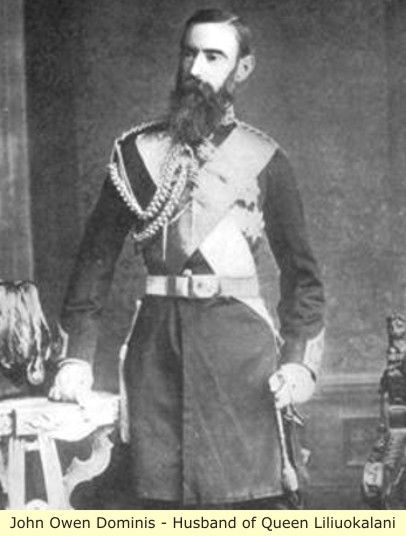 |
 |

Liliuokalani was a courageous and intelligent woman. During her brother's reign she served as regent of Hawaii during his absences. She was over 50 when she became queen of Hawaii. Her husband became governor of Oahu and Maui, but died after just seven months. Liliuokalani never remarried. She named her niece, Princess Kaiulani, as her heir. Kaiulani was away at school in London at this time.
A strong nationalist, Liluokalani tried to replace the Bayonet Constitution with one which would favor native Hawaiians, but was intimidated her into letting the old constitution stand. In 1892 the Hawaiian Legislature passed a law permitting the import and sale of opium. The bill favored Chinese businessmen, and Americans were enraged when the queen signed it, although according to the Bayonet Constitution she had no choice but to sign every bill the legislature passed. She was also castigated for signing a bill that legalized the lottery.
U.S. minister John L. Stevens conspired with other non-Hawaiians to overthrow the queen. In January 1893, armed troops were sent ashore from a warship in Honolulu Harbor, and Liliokalani was forced to surrender. A provisional government took control of Hawaii.
The queen's heir, Princess Kaiulani, went to Washington to appeal for help. Her dignity impressed President Cleveland, who ordered an investigation of the revolution. The report he received convinced Cleveland that the queen should be returned to her throne. He made a speech to congress condemning the overthrow of the monarchy, calling it "a misuse of the name and power of the United States." Cleveland refused to annex Hawaii because the majority of Hawaiians were not in favor of it.
In 1894 the Republic of Hawaii was established with Sanford Dole as its president. In 1895 native Hawaiians, led again by Robert Wilcox, revolted in an attempt to return the queen to power. After 10 days of fighting, Wilcox and most of the other royalists were captured. They were sentenced to death, but saved by intervention of the U.S. government.
 Firearms
were discovered buried in the queen's flower garden, and she was
arrested. For eight months she was held prisoner in one room of the
Iolani Palace. She was charged with misprision of treason (knowing
about treason and not reporting it). Her trial by military tribunal was
held in the former throne room of her palace. The queen was found
guilty and sentenced to a $5,000 fine and five years of hard labor. The
sentence was not carried out, however. She abdicated in 1895.
Firearms
were discovered buried in the queen's flower garden, and she was
arrested. For eight months she was held prisoner in one room of the
Iolani Palace. She was charged with misprision of treason (knowing
about treason and not reporting it). Her trial by military tribunal was
held in the former throne room of her palace. The queen was found
guilty and sentenced to a $5,000 fine and five years of hard labor. The
sentence was not carried out, however. She abdicated in 1895.
On New Year's Day, 1896, Wilcox and the other royalists were released. Queen Liliuokalani was not freed until later that year. Upon her release she went to Washington and was warmly welcomed by President Cleveland. But Cleveland was unable to help her. "I am ashamed of the whole affair," he wrote later.
The queen's heir, Princess Kaiulani, died in 1899 at the age of 23. Liliuokalani continued to live in Hawaii. She regained some of her crown lands, received a pension from the state, and also had income from the properties she owned. She attended most state occasions. But she didn't attend the ceremonies marking the U.S. annexation of Hawaii because she didn't want to see the Hawaiian flag lowered and the American flag raised.
In 1917 Liliuokalani had a stroke and died in Honolulu. She was 79. Today she is remembered as the composer of over 100 songs, including the famous "Aloha Oe." There is a statue of the queen, sculpted by Marianne Pineda, at the State Capitol in Honolulu.
 |
 |
 |
 |
Kamehameha I (1810-1819) Kamehameha II (1819-1824) King Kamehameha III (1825-1854) |
King Kamehameha IV (1854-1863) King Kalakaua (1874-1891) Queen Lili'uokalani (1891-1917) |
In 1898 Hawaii was finally annexed by the United States, and in 1900 it became a U.S. territory. On August 21, 1959 it became the 50th American state.
In 1991 at the Eighteenth General Synod held in Virginia: the United Church of Christ formally apologized for the overthrow of the Kingdom of Hawaii.
In 1993 Congress and President Clinton formally apologized for the overthrow of the Kingdom of Hawaii.
However, Neither body advocated giving it back. Which is just as well, because original Hawaiians are now extinct - a few mulattoes is all that's left.
For the 2010 census, 9.96% of Hawaii's population described themselves as "Native Hawaiian "OR" other Pacific native alone - they are of course Mulattoes of various hues. In mainland United States, those calling themselves "Native Americans" have adopted 1/8 (a Quadroon) as sufficient to qualify as "Native American".
 |
 |
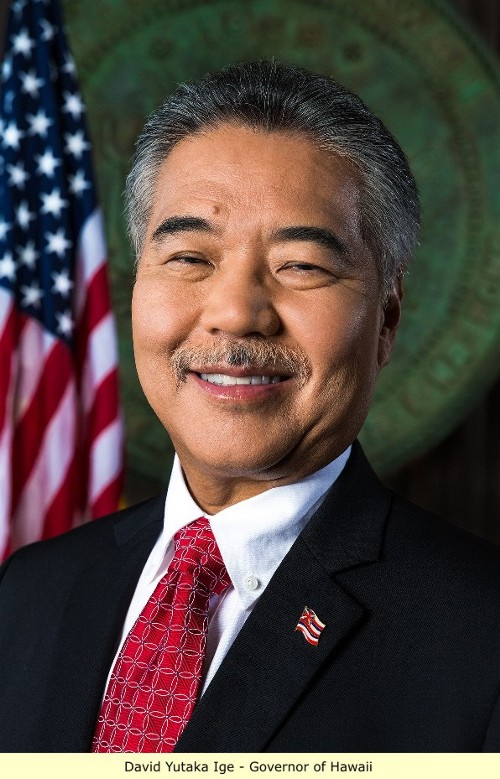 |
 |
 |
 |
HAWAIIAN PATERNAL - Direct paternal line reported as Native Hawaiian
(Remembering that full-blood Hawaiians are Black Pacificans, regardless of the fake made-up "Nesian" tags of the Albinos.
According to researchers, Y-DNA (direct paternal lines) in Polynesia has more haplogroup variations than mtDNA (direct maternal lines); however, about 75% reporting their paternal line as Polynesian are in one of the below three Y-DNA haplogroups:
1) Haplogroup C2 [M38]
This is the haplogroup of about 34% who report their paternal line as Polynesian.
C2 is found in Polynesia, Melanesia, New Guinea, and Indonesia.
2) Haplogroup O [M122]
This is the haplogroup of about 24% who report their paternal line as Polynesian.
O is typical of populations of East Asia, Southeast Asia, and
culturally Austronesian regions of Oceania [includes Polynesia], with a
moderate distribution in Central Asia [ISOGG tree - O3 M122] .
3) Haplogroup K [M9]
This is the haplogroup of about 18% who report their paternal line as Polynesian.
K is an old lineage presently found only at low frequencies in Africa,
Asia, and in the South Pacific. One descendent line of this lineage is
restricted to aboriginal Australians, while another is found at low
frequency in southern Europe, Northern Africa, and the Middle East.
mtDNA Haplogroup B
This lineage is found in eastern and southeastern Eurasia, Native
American Indians, and Polynesia. B is estimated to be the mtDNA
haplogroup of about 93% of the males and females living today who
report their maternal line as Polynesian. The group of mutations
16189C, 16217C, 16247G, and 16261T collectively define the "Polynesian
Motif" ("PM"), a special subgroup of haplogroup B which is found almost
exclusively in Polynesia.
 |
Some Wikipedia;
The Samoan Islands are an archipelago in the central South Pacific,
forming part of Polynesia and the wider region of Oceania.
Administratively, the archipelago comprises all of Samoa and most of
American Samoa (apart from Swains Island, which is part of the Tokelau
Islands). The two Samoan jurisdictions are separated by 64 km (40 mi)
of ocean. The population of the Samoan Islands is approximately
250,000, sharing a common language, Samoan, a culture, known as fa'a
Samoa and an indigenous form of governance called fa'amatai. Most
Samoans are full-blooded and are one of the largest Polynesian
populations in the world. (Typical Albino lie, make believe that the
current mulattoes are the original people).
The current Islands known as “Samoa” were formerly
called Western Samoa. They were originally settled by the Tongan
Polynesians. The oldest evidence of human activity in the Samoan
Islands dates to around 1050 B.C. This comes from a Lapita site at
Mulifanua wharf on Upolu Island. It was the European explorers and
missionaries that transformed these islands for better or for worse.
Christianity was introduced to the natives, and many local customs soon
disappeared. In the late 1800s, rivalry between the United States,
Germany, and the United Kingdom resulted in the Tripartite Convention
(1899) that formally partitioned the Samoan archipelago into a German
colony (German Samoa) and a United States territory (American Samoa).
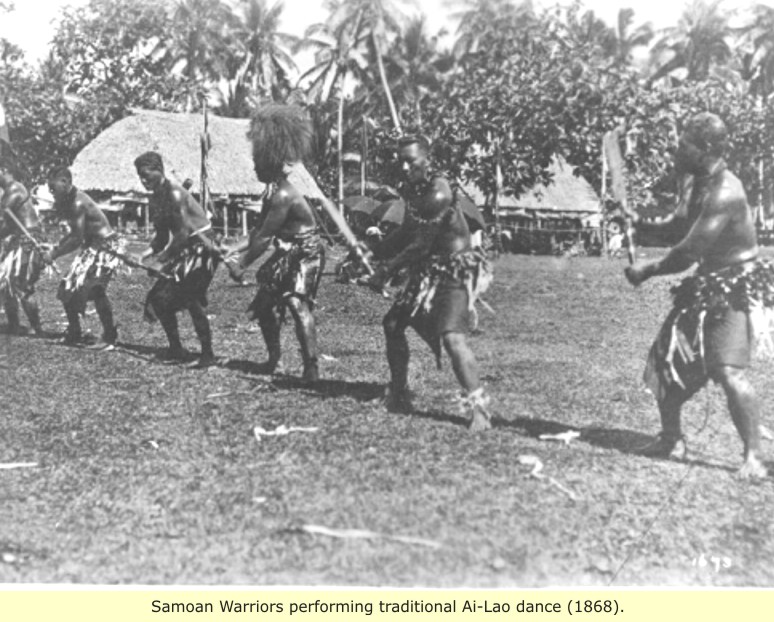 |
Usurping native rule: Forerunners to the Tripartite
Convention of 1899 were the Washington Conference of 1887, the Treaty
of Berlin of 1889 and the Anglo-German Agreement on Samoa of 1899. The
following year, the U.S. formally annexed its portion, a smaller group
of eastern islands, one of which contains the noted harbor of Pago
Pago. After the United States Navy took possession of eastern Samoa for
the United States government. The existing coaling station at Pago Pago
Bay was expanded into a full naval station, known as United States
Naval Station Tutuila and commanded by a commandant. The Navy secured a
Deed of Cession of Tutuila in 1900 and a Deed of Cession of Manuʻa in
1904 on behalf of the US government. The last sovereign of Manuʻa, the
Tui Manuʻa Elisala, signed a Deed of Cession of Manuʻa following a
series of U.S. naval trials, known as the "Trial of the Ipu", in Pago
Pago, Taʻu, and aboard a Pacific Squadron gunboat. The territory became
known as the U.S. Naval Station Tutuila.
On July 17, 1911, the US Naval Station Tutuila, which was composed of Tutuila, Aunu'u and Manu'a, was officially renamed American Samoa. People of Manu'a had been unhappy since they were left out of the name "Naval Station Tutuila". In May 1911, Governor William Michael Crose authored a letter to the Secretary of the Navy conveying the sentiments of Manu'a. The department responded that the people should choose a name for their new territory. The traditional leaders chose “American Samoa”, and, on July 7, 1911, the solicitor general of the Navy authorized the governor to proclaim it as the name for the new territory.
Native American Samoans are "nationals but NOT citizens of the United
States at birth”. As well as birthright citizenship NOT applying on the
islands, American Samoans cannot vote in the American Presidential
elections. Non-voting members of the United States House of
Representatives (called either delegates or resident commissioner, in
the case of Puerto Rico) are representatives of their territory in the
House of Representatives, who do not have a right to vote on proposed
legislation in the full House but nevertheless have floor privileges
and are able to participate in certain other House functions.
Non-voting members may vote in a House committee of
which they are a member and introduce legislation. There are currently
six non-voting members: a delegate representing the federal district of
Washington D.C., a resident commissioner representing Puerto Rico
(Puerto Ricans have been citizens of the United States since 1917), and
one delegate for each of the other four permanently inhabited US
territories: American Samoa, Guam, the Northern Mariana Islands, and
the US Virgin Islands. (Although they are U.S. citizens, U.S. Virgin
Islanders residing in the territory are ineligible to vote for the
president of the United States. They are, however, eligible to vote if
they become residents of a state: same as Puerto Ricans. American Samoa
is noted for having the highest rate of military enlistment of any U.S.
state or territory.
 |
At the conclusion of World War I, and for 42 years, New
Zealand occupied and administered the islands. The pro-independence Mau
movement across the islands eventually led to the political
independence of the western islands from New Zealand in 1962; while the
eastern islands, American Samoa, remains a political territory of the
United States. Then, in 1962, Samoa (not America Samoa) became the
first Polynesian nation to reestablish its independence in the 20th
Century. The local population is mostly indigenous Samoans. The port
city of Apia is the center of local government and trade, and the
economy revolves around agriculture, lumber and tourism. In 1930, the
U.S. Congress sent a committee to investigate the status of American
Samoa, led by Americans who had a part in the overthrow of the Kingdom
of Hawaii.
 |
Tui Manu'a Matelita, born Margaret Young, and also known as Makelita, Matelika or Lika (31 December 1872 – 29 October 1895) was the Tui Manu'a (paramount chief or queen) from 1891 to 1895. She ruled over Manu'a, a group of islands in the eastern part of the Samoan Islands (present day American Samoa). During her tenure, she served largely a ceremonial role at her residence on Ta'ū where she received British writer Robert Louis Stevenson. Matelita never married because she would not marry any of the eligible native chieftains and no other men were regarded as having the proper rank to marry her. She died of illness in 1895 although later reports claimed she died by a more violent means. She was buried in the Tui Manu'a Graves Monument.
Tui Manu'a Matelita, born Margaret Young, and also
known as Makelita, Matelika or Lika (31 December 1872 – 29 October
1895) was the Tui Manu'a (paramount chief or queen) from 1891 to 1895.
She ruled over Manu'a, a group of islands in the eastern part of the
Samoan Islands (present day American Samoa). During her tenure, she
served largely a ceremonial role at her residence on Ta'ū where she
received British writer Robert Louis Stevenson. Matelita never married
because she would not marry any of the eligible native chieftains and
no other men were regarded as having the proper rank to marry her. She
died of illness in 1895 although later reports claimed she died by a
more violent means. She was buried in the Tui Manu'a Graves Monument.
After the death of Tui Manu'a Alalamua, the paramount title was left vacant and disputed. An election took place in the faletolu, the council which traditionally decided on the next Tui Manu'a. The two candidates were Matelita and Taofi, a son of Tui Manu'a Tauveve. The anoalo led by Arthur Paʻu Young weighed in in favor of Matelita. The decision was not ccepted initially by the main line of the Tui Manu'a, but Taofi conceded to Matelita and she became the new paramount chief of the group, ascending to the title on 1 July 1891. She was crowned in a traditional ceremony consisting of feasting, offering of food, kava drinking in the days before and after 13 July 1891. During her tenure, she primarily filled a ceremonial role and resided on the main island of Ta'ū. In 1895, she gave a speech consecrating a new church. Contemporary and posthumous European and American accounts of her life portray her as a mere figurehead and as a white queen of the South Seas. Matelita never married because she would not marry any of the eligible native chieftains and no other men were regarded as having the proper rank to marry her.
 |
Robert Louis Stevenson, a British writer and expatriate
in Samoa, visited Matelita and the islands of the Manu'a group in 1894
aboard HMS Curacoa (1878). He wrote: The three islands of Manu'a are
independent, and are ruled over by a little slip of a half-caste girl
about twenty, who sits all day in a pink gown, in a little white
European house with about a quarter of an acre of roses in front of it,
looking at the palm-trees on the village street, and listening to the
surf. This, so far as I could discover, was all she had to do. "This is
a very dull place," she said. It appears she could go to no other
village for fear of raising the jealousy of her own people in the
capital. And as for going about "tapatafaoing," as we say here, its
cost was too enormous. A strong able-bodied native must walk in front
of her and blow the conch shell continuously from the moment she leaves
one house until the moment she enters another. —Robert Louis Stevenson,
July 7, 1894
Matelita fell ill in September 1895 and died peacefully
in her sleep, after the illness, on 29 October 1895. Later sources
claimed she died after a kerosene lamp overturned causing her mosquito
net to catch fire while she slept. This is not supported by
contemporary sources of the Protestant missionaries which stated she
died of illness. Elisala was elected as her successor to the title Tui
Manu'a in 1899. After Elisala's death, the title was abolished by the
United States, which had earlier incorporated the islands as a part of
American Samoa. Matelita's brother Chris Taliutafa Young unsuccessfully
attempted to claim the Tui Manu'a in 1924.
 |
From Local Media
The first wave of Chinese immigrants arrived in Samoa in the late 19th Century. As time stretched on and the more that came (be it as free settlers or indentured laborers), they integrated into the culture, learnt the fa'asamoa, married Samoans, had Samoan families and eventually died in Samoa as Samoans. The legacy they left behind is powerful and can be seen in the culture and the people of Samoa today.
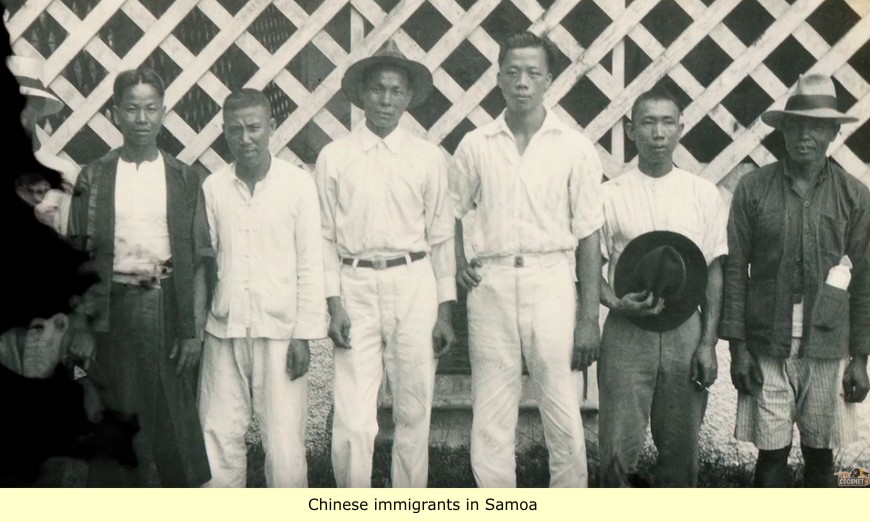 |
 |
 |
 |
 |
 |
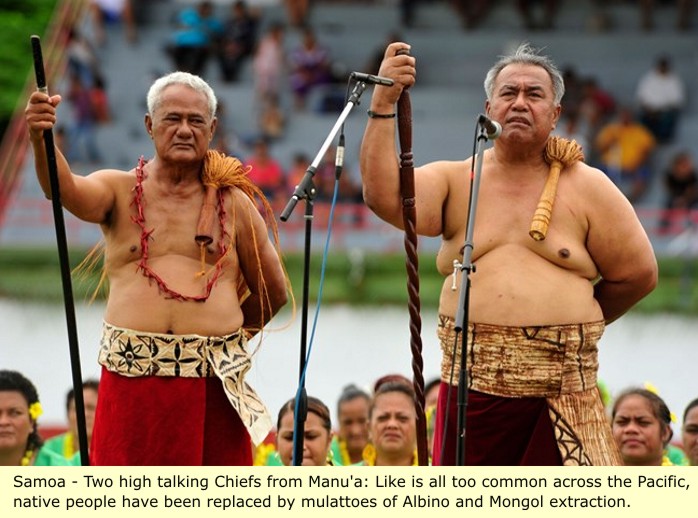 |
 |
Tulsi Gabbard born April 12, 1981; is a American politician and Hawaii Army National Guard major who serves as the U.S. Representative for Hawaii's 2nd congressional district. Elected in 2013, she became the first Samoan member of Congress.
Gabbard was born on April 12, 1981, in Leloaloa,
Maoputasi County, on American Samoa's main island of Tutuila. She was
the fourth of five children born to Mike Gabbard (Her father is of
Samoan and European ancestry) and his wife Carol (née Porter) Gabbard,
was born in Decatur, Indiana, and is of German descent. In 1983, when
Gabbard was two years old, her family moved to Hawaii. Her father is a
member of the Hawaii Senate. That makes Tulsi Gabbard an Albino with
25% Samoan ancestry, Not a Samoan!
Because of all the Albino and Mongol Mulattoes now in the Pacific; visitors to Quora, which is an American question-and-answer website where questions are asked, answered, and edited by Internet users, either factually, or in the form of opinions (Its owner is Quora Inc). At Quora the question is asked: Are Samoans classified as black? Here are some very interesting answers. << Click here to see the answers >>
It's really a Mulatto image.
The albinos and their media, in their never-ending efforts to give the impression that the world looks like them. Have relentlessly featured images of their mulattoes, as well as Mongol mulattoes, as being indicative of Pacific populations.
 |
 |
 |
The Lapita Voyage is an expedition that sailed on the migration route of the ancient Polynesians under the direction of Klaus Hympendahl. It follows the migration of the Polynesians from the Philippines on to the Indonesian Moluccas islands, along the north coast of Guinea, the Solomon Islands through the archipelago and the islands of Tikopia and Anuta. The Albinos have tried to convince the world that these places are now inhabited by their mulattoes - lets see if it's true.
 |
 |
 |
 |
 |
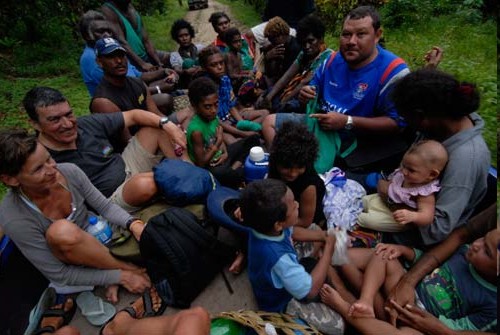 |
 |
 |
 |
 |
 |
 |
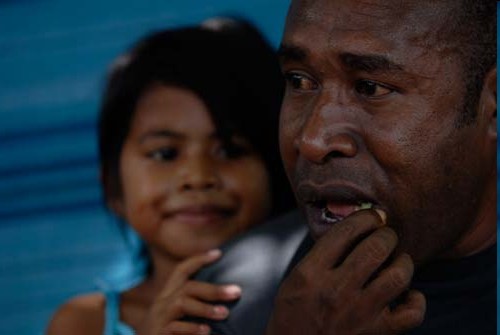 |
 |
 |
 |
 |
 |
 |
 |
 |
 |
| < Back | Home |